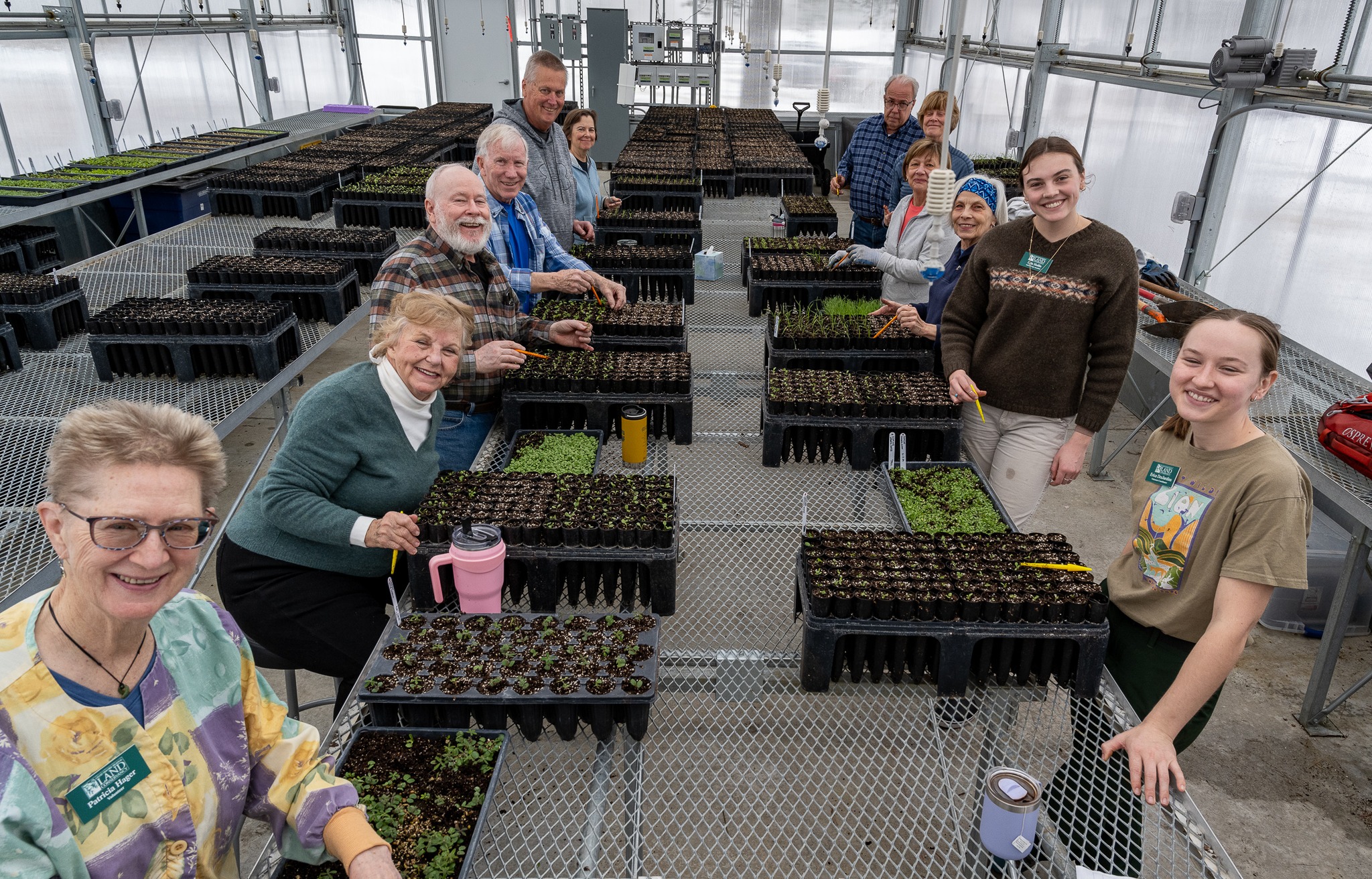Boomer Boom: Six ways retirees are affecting the Grand Traverse region
October 2024
Beaches, boats, golf, wine, sunshine.
These are just a few of the draws that have helped make Traverse City and the broader Grand Traverse region the most popular destination for retirees in Michigan. While local retirees don’t necessarily live here year-round – often trading the area’s cold winter weather for the warmer climates of places like Florida or Arizona – they undoubtedly have a massive impact on the regional community, economy and environment. Some of those impacts are predictable, like the way retirees skew Traverse City’s demographic statistics. Others are less explored, like how thoroughly older adults dominate the local volunteer force.
This month, in honor of our area’s retirees, the TCBN takes a look at six distinct ways in which retirees are totally changing the narrative of how Traverse City operates.
-
They change our demographics
On average, the Grand Traverse region skews older than other parts of the state. According to 2022 Census Bureau data, the median age in Grand Traverse County is 43.1, compared to 40.1 for Michigan as a whole. Some local counties skew even older, like Leelanau County, which has a median age of 55.2.
Roughly 21,000 people, or 22% of Grand Traverse County’s 96,500-person population, is 65 or older, compared to just 18.7% for the state as a whole.
The region has also gotten dramatically older in the past decade: As of the 2010 Census, just 12,886 Grand Traverse County residents fell into the 65-and-over demographic – about 14.8% of the population at the time.
Local demographics are poised to skew older and older in the years to come, based on the number of people in the area who are nearing retirement age. Per Census data, the three biggest five-year age ranges in the county, based on population, are 55-59 (7,336 people), 60-64 (7,057 people), and 65-69 (6,271 people).
Only one other age bracket tops 6,000 residents in Grand Traverse County: 30-34, which boasts 6,185 people.
- They drive growing needs for in-home care and senior living
With northern Michigan’s population increasingly skewing toward older demographics, those working in the senior care industry have been fretting for years about whether the region has the infrastructure and services necessary to support the aging population. From senior living communities to in-home care providers, professionals in this space have repeatedly told the TCBN and its sister publications that they lack the space and/or staff to meet the needs they expect the region will face in the coming decades.

In fact, according to Amy Northway, president and CEO of Traverse City’s Monarch Home Health Services, the situation is already reaching a fever pitch.
“Monarch has been in contact with significantly more older children who are involved in the long-term care of their parents and loved ones,” Northway said. “The children may be moving their loved ones into their homes, or into assisted living communities, but still want to travel and have the freedom to enjoy their retirement years. As a result, there are more and more requests for weekend caregivers and extended caregivers.”
The good news, Northway says, is that older adults and their families are starting to be more proactive when it comes to planning for senior care. All the discussion about worker and capacity shortages in recent years, she notes, has helped people recognize that “there is a need for reliable relationships with in-home care companies to provide short and long-term care on an as-needed basis.” While Northway still doesn’t think the region has enough caregivers to keep up with demand, she sees the uptick in caregiver applications as a “positive" sign that families are planning ahead.
In particular, Northway says there has been a notably increase in families establishing relationships with companies like Monarch before they need care – not when the need arises.
“Monarch Home Health Services has been conducting more and more ‘reserved’ interviews, as we refer to them, to have paperwork and introductions in place, as caregiving services are often needed with little advance notice,” Northway explained. “This allows for on-demand types of services for those with the means to provide care for their loved ones while they enjoy their lives up north.”
- They affect the region’s number of “dark” homes
Many of the region’s retirees are snowbirds, or people who own homes in northern Michigan, but only live here part-time. That part-time population – and the number of local homes they hold down as second or seasonal homes – means that Traverse City and its surrounding areas have a disproportionately high number of homes that sit empty and dark in the winter.
Speaking to TCBN sister publication the Traverse City Ticker in 2021, Polly Cairns, the then-city assessor for the City of Traverse City, said that “approximately 55% of residential-classed property for the City of Traverse City Leelanau County portion and 42% for the City of Traverse City Grand Traverse County portion” have principal residence exemptions. In other words, roughly half of the homes in Traverse City are second homes, not primary residences.
Regional numbers are high, too. In 2022, Networks Northwest and Beckett & Raedar published a seasonal population study for northwest Lower Michigan, which found that the population for the 10-county region swells by 78% in the summer. That number does include tourism, with overnight visitors making up 40% of the region’s total population during the peak month of July. However, the report also specifically tallied the region’s part-time/second-home population, finding that some 96,566 part-time residents call the area home during the summer months.
The number of seasonal homes in the region has become a hot-button issue in recent years as demand for – and cost of – housing has skyrocketed.
Per a 2023 Housing Needs Assessment from Housing North, vacation rentals and seasonal housing now account for more than a quarter of the total housing in the 10-county region, ranging from as low as 9.8% in Grand Traverse County to 40.3% in Benzie County. The report stated that recent increases in seasonal and short-term rental housing were “chipping away" at permanent housing stock across northern Michigan, and advocated finding a way to address this market, "particularly given the lack of rental and for-sale housing product that is available."
- They bolster the local volunteer force
The Grand Traverse Regional Land Conservancy (GTRLC) relies on an army of some 350 volunteers to carry out its mission of environmental preservation and stewardship in northwest Lower Michigan. Across six local counties, the organization protects more than 47,000 acres of land and 155 miles of shoreline. Volunteers lend a hand by building and maintaining trails, leading community hikes, spearheading events, assisting with efforts to combat invasive species, and more.
According to GTRLC Volunteer Coordinator Erica DesJardins, approximately 75% of the organization’s volunteers are retirees.
 GTRLC volunteers work in the organization's native plant greenhouse.
GTRLC volunteers work in the organization's native plant greenhouse.“There are so many examples, from our volunteer base, of retirees really committing themselves to our mission and going above and beyond what would be expected of a volunteer,” DesJardins said, before listing a few standout examples. One is Paula Dreeszen, a 66-year-old retiree from Interlochen who will be celebrating her 20th year of volunteering for GTRLC in 2025.
“Paula is a lead volunteer in our southwest region – which includes Manistee and Benzie counties – and manages most of the communication with volunteers in that area,” DesJardins said. “She sends weekly regional emails to those volunteers to keep everyone in the loop, coordinates trail maintenance and chainsaw response when it's needed down there, and even leads a series of invasive species removal workbees in the summer in the Arcadia area. Her knowledge of Arcadia Dunes is totally unmatched, and she keeps excellent records of her work and observations there from over the years.”
There are other examples, too. One is Anne Sutton, who coordinates a group of 30-40 volunteers for GTRLC’s Maple Bay Farm, which last year donated more than 6,000 pounds of organic produce to local food pantries. Another is Rick Hager, who used to work as a land manager for the U.S. Fish and Wildlife Service in Iowa. Since retiring to northern Michigan, he’s put his technical skills to work for GTRLC, leading projects around seed collection, invasive species removal and prescribed burns.
“Older adults are having a huge impact on helping us advance our mission,” said GTRLC Executive Director Glen Chown. “The numbers are large, but more importantly, the impact they make is very significant.”
- They fill seasonal, part-time and even full-time jobs
Even beyond volunteer capacities, “older workers and/or retirees are very prevalent in our workforce in our region,” according to Rob Dickinson, regional director of business services for Networks Northwest.
Networks Northwest offers a variety of workforce, business, community and economic development services throughout the 10-county region, often acting as a matchmaker to connect job seekers with employers, or vice versa.
While the organization serves all demographic ranges, Dickinson says older adults have become a bigger part of the equation over the past 10 years or so.
“This is all anecdotal, but retirees are coming into our offices looking for work for lots of reasons,” Dickinson shared. “The most often relayed message is that they cannot afford to simply not work at this point. There is also a segment of older workers that are let go from their long-time employer and are struggling to find new employment.”
What older adults are looking for from Networks Northwest programs can vary, Dickinson says certain types of work and certain industry sectors tend to be more popular among older demographics than others.
“Some retirees are looking to work in less demanding positions – so, part-time, seasonal and gig work are appealing,” Dickinson shared. “We are also seeing more older job seekers take jobs at retail and hospitality establishments. Retirees are finding their way to us in hopes of being connected to their next job in many industries, though. Our job seeker side of the house tells us that the individuals they are working with are frequently inquiring about manufacturing jobs and even post office positions, both full-time and part-time.”
In recent years, as talent shortages have pushed employers throughout the region to get more creative in filling vacant positions, Dickinson says it’s become easier to find good job opportunities for retirees.
“Employers at this point in time are opening up who they are willing to hire, and some are even targeting retirees or older workers,” Dickinson noted.
One example he cites is Plato’s Closet, a chain retailer in Garfield Township that buys and sells secondhand clothing for teenagers and young adults.
“They were on radio wanting seniors to apply for their part time positions,” Dickinson said.
Statistically, employment among older demographics is on the rise. According to a 2023 analysis from the Pew Research Center, roughly 19% of the approximately 11 million Americans that slot into the 65-and-older demographic are employed – a significantly higher share than in past generations.
For instance, in 1987, only 11% of the country’s 65-and-over population was working. The higher percentage, plus the fact that the 65-plus demographic is roughly four times bigger now than it was in the mid-to-late 1980s, shows the changing norms of employment among senior citizens.
- They bring institutional knowledge and investment capital to the table
While some local retirees are filling their time with volunteer work or part-time jobs, others are injecting lifeblood into the region’s economic development scene.
So says Warren Call, president and CEO of Traverse Connect. The region, Call notes, is a magnet for retirees who have had quite a bit of success in their careers and are looking to pay that success forward to the next generation.
Examples include Northern Michigan Angels, an angel investment group whose members invest in "scalable, early-stage companies” from throughout the state; majority of that group’s members are retirees. It’s also common, Call notes, for retirees to act as business mentors through SCORE, to sit on local nonprofit boards, to serve businesses or organizations in advisory capacities and more.
“The institutional knowledge of our retirees and seasonal residents is immensely valuable, and one of the unique attributes of this area that is a positive differentiator for us,” Call said. “These are accomplished people that have done impressive things all over the world, and their engagement and sharing of experience benefits our region, community and economy in a number of ways. Not only do they serve on boards and committees, volunteer for nonprofits and provide expertise and funding to our companies, they also serve as direct mentors for business, nonprofit and community leaders. Their generosity and passion for making this a great place is truly appreciated.”














